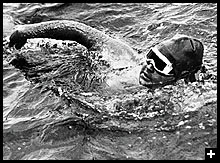Gertrude Ederle: Concurring the English Channel
In honor of women’s history month, we recognize as the Sports Then and Now Vintage Athlete of the Month a woman who not only was the first woman to successfully swim the English Channel, but swam the channel faster than any person (man or woman) had done to that point in history.
Having proven her swimming ability while winning one gold and two bronze medals during the 1924 Summer Olympics, American Gertrude Ederle swam the challenging English Channel faster than any human previously when she swam from France to England in a time of 14 hours and 39 minutes on August 6, 1926.
The previous record time of 16 hours and 33 minutes had been set by Enrique Tirabocchi of Argentina in 1923, but Ederle would navigate the waters in a time that would not be eclipsed until Florence Chadwick crossed the channel in 13 hours and 20 minutes in 1950.
Ederle was one of several women vying to become the first woman to cross the English Channel. Several women, including Ederle, were sponsored by newspapers looking to get the “scoop” on this historic accomplishment. Ederle was sponsored by the New York Daily News and Chicago Tribune, which provided her a modest salary while also covering her expenses.
A year before her successful attempt, on August 18, 1925, the five-foot-six inch Ederle made her first attempt only to be disqualified when her trainer, Jabezz Wolffe, ordered a swimmer that was keeping her company in the water to help her when he thought she was struggling. Ederle was furious as she (along with other witnesses) claimed that she was floating face-down.
Before her record swim, Wolffe was replaced with Thomas Burgess, who in 1911 had become the second person ever to successfully cross the channel.
Beginning her swim at 7:08 a.m., Ederle navigated the rough waters with her entourage alongside in a tug boat. In addition to her coach and family members, also on board was writer Julia Harpman from the New York Daily News, which was sponsoring the effort. Because Harpman would not let any other writers on the boat, other writers hired another tug boat to follow the excursion.
The other boat got close to Ederle on several occasions and nearly endangered the swimmer. Some critics claim that having the two boats shielded some of the harsh weather and made it easier for Ederle to navigate the treacherous waters.
When the 20-year-old Ederle reached the shore after more than 14 hours in the water, she was met by a British immigration officer who asked to see her passport.
The welcome she received back in the United States was significantly friendlier as she was given a ticker tape parade in New York City with more than two million people lining the streets to congratulate the new American hero.
Ederle went on to meet President Coolidge and appeared as herself in a pair of movies and on the vaudeville circuit.
As a child Ederle had suffered hearing loss due to the measles and by the 1940s was nearly completely deaf. She went on to teach swimming to deaf children. Ederle lived to be 98-years-old, passing away in 2003.

Thank you, I've recently been searching for information about this subject for a while and yours is the best I have discovered so far.
I am doing research on this topic. this blog is much helpful for me in my research.
What's Taking place i'm new to this, I stumbled upon this I've found It positively useful and it has aided me out loads.
For the reason that the admin of this site is working, no uncertainty very rapidly it will
be well-known, due to its feature contents.
My web site :: that guy
Really when someone doesn’t know then its up to other
people that they will assist, so here it happens.
my blog … Locksmith olney Md
The history has proved that women are no less better then men and are of an equal strength to them. Women of all times have shown the world that they may not be underestimated and they have competed the power of man with an equal strength.